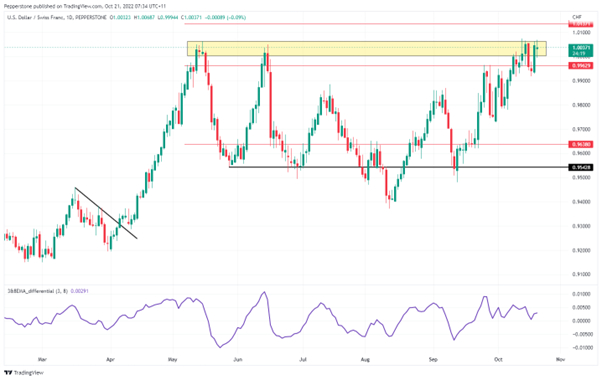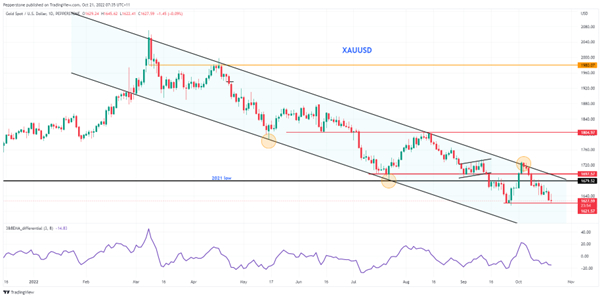After much anticipation, Liz Truss leaves Downing Street after 44 days on the job, and the process of finding a new PM kicks in – 100 Tory MP nominations are needed (out of a possible 357) , and that means we should see 2 or 3 candidate in the running early next week – Rishi Sunak is the clear front-runner but Boris Johnson is making a play and the flow of betting capital follows Boris.
We should learn more of the riders by early next week, for the announcement to be made on Friday – GBP/USD has had somewhat of a whippy ride, with buyers into 1.1336 before US Treasuries started finding sellers and yields marched higher, resulting in the USD reversing hard.
GBP volatility should be contained given the budget is still to be released on Oct. 31. That said, the counterargument to that is we see volatility arise from the uncertainty stemming from the BoE meeting on Nov 3 – 91bp of hikes are priced in by the market, and while the consensus has been for a 100bp hike, there is a growing belief that it could be 75bp – one to consider next week.
EUR/GBP is good to put on the radar as a cleaner expression of the GBP (it removes USD risk) and a tactical view of next week’s ECB meeting – the set-up needs work with two clear days of indecision in the price action– as a momentum trade the daily needs a push through 0.8733 and we could be looking at 0.8900 - traders tend to shy away from this cross as price action is more of a grind than the big intraday ranges you get in the USD pairs.
It is the US bond show that drives broad markets, and while liquidity is an issue, talk is there are just no buyers – We also see ‘terminal’ rate pricing for the fed funds rate is now above 5%, and United States 5-Yearr Treasuries (now 4.45%) are eyeing a move into 4.5%.
US real rates creep higher, which is worryingly for risk, and we see 5yr real rates at 1.91% and the top of the range of 2%. As mentioned before, terminal fed funds pricing and US real rates are where the USD is most focused and if that moves higher, then so does the buck, and that weighs on risky assets like equity.

We see USD/JPY now holding ¥150 and up for an incredible 12 straight days, and again this is probably one of the cleaner plays on the US rates markets – USD/CHF sits above parity and into supply seen since May – one for those who like potential breakouts or trading around big levels. I would rather wait for the break and see if the USD bulls could keep the pace going and join as a momentum/trend trade than act now – as we know, failed breaks at major levels like this can be incredibly powerful reversal signals.
Equity markets have been heavy, as you’d expect when rates are selling off, and the USD has turned higher – Positioning-wise, clients are concentrating their trading in NASDAQ, with a small skew to be long, but the flow is nuanced. Volumes through the underlying have been ok, with S&P 500 cash volumes 9% above the 30-day average and 2.1m futures contracts traded.
Intra-day price action has been whippy, but we find ourselves near the lows of the day at 3663, with most of the volume traded at 3697 (VWAP is 3702) – again, this is the influence the bond market has made. For now, we hold 3600 – the bottom of the 3-week trading range – the question being, does it hold? My base case is we trade a 3600-3800 range for the next few weeks, but naturally, a break of 3600 needs to be respected and opens us up for a move to 3300.
With 47% of the S&P 500 market cap reporting next week, earnings will get a greater say but still compete full force with the macro. Oil is on the radar as it breaks the flag pattern - the buyers have no conviction here, and it’s a brave call (so keep positioning to a minimum), but I like it short here and would place a tight stop above 88.30.

In a rising rates world, the natural default position is to short the JPY – but while hedge funds get paid to do so (from the carry), its gold that attracts our client flow – the skew, as we push into the Sept swing lows of 1620, is now long (61% of open positions are held long) – presumably many will be scalping off the level. A break of 1620 marries with a further rise in bond yields and USD strength, potentially setting us up for a move to channel lows of $1540.
